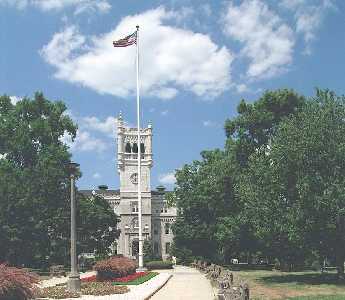
U.S. Soldiers' and Airmen's
Home (USSAH) Washington, D.C.

U.S. Soldiers' and Airmen's
Home (USSAH) Washington, D.C.
| History of the U.S. Soldiers' Home
Beautiful, century-old buildings stand
as testament to the rich history that makes up one of America's oldest
veterans' retirement homes. The Soldiers' Home was established in 1851,
as an "asylum for old and disabled veterans." Four of the original
buildings still stand and are listed as national historic landmarks. Two
of the buildings, Quarters 1 and Anderson Cottage, served as the summer
White House for U.S. presidents -- Chester Arthur, Rutherford B. Hayes,
James Buchanan and, most notably, Abraham Lincoln.
Lincoln lived at the Soldiers' Home in what is now called Anderson Cottage during our nation's most turbulent history, the Civil War. Not only was it a break from the hot, humid city, but also from the intense political pressures of being president. In fact, Lincoln spent one-fourth of his presidency at Soldiers' Home, and it was here that he wrote the last draft of the Emancipation Proclamation. In 1865, Lincoln's wife, Mary, wrote to her friend Elizabeth Blair Lee, "How dearly I loved the Soldiers' Home." Historic Anderson Cottage was constructed in 1842-43 as the home of George W. Riggs, who went on to establish the famous Riggs National Bank in Washington, D.C. In 1851, the cottage and farm land surrounding it was purchased by the government to form the core of what is today the U.S. Soldiers' and Airmen's Home. This Early Gothic Revival cottage served as the first quarters for the "inmates" of the "asylum." They lived here for approximately five years, until they moved into the Scott (now called Sherman) dormitory to the east of Anderson Cottage. This building also was the home's first hospital and guest house and is where the women were housed when they were first admitted to the Home in 1954. The Cottage was named after Maj. Robert Anderson, who commanded the Union's Fort Sumter S.C., where the Civil War's first volleys were fired. Anderson, along with Jefferson Davis, and most important, Gen. Winfield Scott, fought to establish a soldiers' home for nearly 25 years. Congress finally approved a bill in 1851, following the Mexican War. In charge of American troops during the war, Scott now was considered an American hero. He returned with $150,000 that was paid to him by Mexico City, in lieu of ransacking. He paid off his troops, bought new supplies, and offered the remaining money to Congress to establish the Soldiers' Home. Since the home's beginning, operational funding came from the soldiers (and later, airmen) themselves. A permanent trust fund was established nearly 150 years ago, and was fed by monthly, active duty payroll deductions of 25 cents, when the average pay of a soldier was $7 a month. All fines and forfeitures from the Army, and later the Air Force, came to the USSAH and, combined with the monthly withholding, provided the principal support for the home throughout its history. The U.S. Soldiers' and Airmen's Home Today Nestled in the heart of our nation's capital on 320 acres of secure, park-like setting, nearly 1,300 veterans have found a home. No longer called "The Old Soldiers' Home," the U.S. Soldiers' and Airmen's Home is a thriving community that offers 20-year retirees and certain veterans a haven of retreat. It is also a perfect example of "The Military Taking Care of Its Own." During its nearly 150-year history, USSAH has evolved from an "asylum for the old and disabled," to a retirement community that offers a secure and comfortable lifestyle filled with activity. Whereas "inmates" once lived in eight-man squad rooms, all of today's residents have private rooms, and many have private baths and walk-in closets. Private vehicles are allowed with ample parking available, and amenities such as cable TV, air-conditioning and elevators are in every building. Three meals a day are served in a modern cafeteria that seats 1,400 people. The facility offers a wide variety of food, including short-order and special diet lines and salad bar. A city within a city, the Home has its own banking facilities and post office, as well as three chapels, a new fitness center/gymnasium and a six-lane bowling alley. The home's private bus leaves daily to take residents to a near by race track, shopping mall, Smithsonian museum's, and many other attractions. For those interested in hobbies, there are arts and crafts shops that cater to everyone's talents, such as woodworking, ceramics, photography, oil painting and picture framing. Near the well-groomed, nine-hole golf course and driving range are garden plots and two tranquil lakes, which offer sport fishing for crappie, bass, bream and catfish. Health care services range from community nursing and assisted living in the dormitories, to primary, intermediate and skilled care at the King Health Center. This 200-bed, well-equipped, long-term care facility received a three-year accreditation with commendation from the Joint Commission on Accreditation of Healthcare Organizations. Licensed specialists in dentistry, optometry, podiatry, internal medicine and diabetes are available, as well as professionals in physical, occupational and recreational therapy, and speech-language pathology. A shuttle bus leaves the home six times a day for Walter Reed Army Medical Center, where residents receive acute care and have access to some of the country's finest doctors and surgeons. Other local hospitals include the Washington VA Medical Center and Bethesda Naval Hospital. To sum up, the home is a total life-care community that adds to an active resident's life now, and provides important services to meet any needs he/she will have in the future. The home is, after all, a special place
for special people. For additional information or call 1-800-422-9988,
visit their Web site at http://www.afrh.com/,
or write: Courtesy of the Armed Forces Retirement Home (AFRH) |